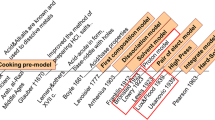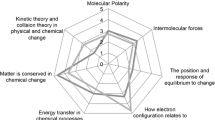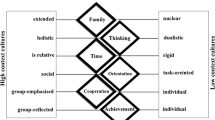ABSTRACT
This study was a mixed quantitative–qualitative research to evaluate the efficacy of a designed student-centred instructional (DSCI) program for teaching about acids and bases. The teaching innovation was designed based on constructivist, hands-on inquiry and context-based approaches and implemented in seven 45-min lessons with a class of 36 grade 11 students (experimental group) from a public senior high school in Indonesia. Another class of 38 students (comparison group) from the same school was instructed using a traditional teacher-centred approach. Data were obtained using a (1) 12-item achievement test on acids and bases that was administered to both groups as a pretest and a posttest, (2) self-evaluation 13-item questionnaire on students’ perceptions of their competence and confidence in carrying out the inquiry activities that was administered to the experimental group and (3) 3-item open-ended questionnaire on students’ perceptions of the instructional process using the DSCI that was administered to the experimental group. The results of the study showed that the teaching innovation was effective in improving students’ understanding of acid–base concepts with significant difference between the two groups on the posttest mean scores. Moreover, the effectiveness of the innovation was supported by an increase in students’ interest in learning science as indicated by their (1) positive perceptions of their engagement and competence in doing inquiry activities, (2) positive perceptions of the learning environment and (3) positive outcome expectations. The findings have implications for chemistry teaching in any institution with similar achieving students as well as for the professional development of teachers.
Similar content being viewed by others
References
Abd-El-Khalick, F., BouJaoude, S., Duschl, R., Lederman, N. G., Mamlok-Naaman, R., Hofstein, A., Niaz, M., Treagust, D. F. & Tuan, H.-L. (2004). Inquiry in science education: International perspectives. Science Education, 88, 397–419.
Ainley, M. (2004). What do we know about student motivation and engagement? Paper presented at the annual meeting of the Australian Association for Research in Education. Melbourne, Australia.
Bandura, A. (1997). Self-efficacy: The exercise of control. New York: W. H. Freeman and Company.
Bass, J. E., Constant, T. L. & Carin, A. A. (2009). Methods for teaching science as inquiry (10th ed.). Boston: Allyn & Bacon.
Berg, K. C. (2006). The status of constructivism in chemical education research and its relationship to the teaching and learning of the concept of idealization in chemistry. Foundations of Chemistry, 8, 153–176.
Carey, S. (1985). Conceptual change in childhood. Cambridge, MA: MIT Press.
Chiappetta, E. L. & Koballa, T. R. (2006). Science instruction in the middle and secondary schools: Developing fundamental knowledge and skills for teaching (6th ed.). Upper Saddle River, NJ: Prentice Hall.
Creswell, J. W. (2008). Educational research: Planning, conducting, and evaluating quantitative and qualitative research (3rd ed.). Upper Saddle River, NJ: Prentice Hall.
Deboer, E. G. (2006). Historical perspective on inquiry teaching in schools. In L. B. Flick & N. G. Lederman (Eds.), Scientific inquiry and nature of science (pp. 17–35). Dordrecht, The Netherlands: Springer.
Fraenkel, J. R. & Wallen, N. E. (2006). How to design and evaluate research in education (6th ed.). New York: McGraw-Hill.
Germann, P. J. & Aram, R. J. (1996). Student’s performances on the science processes of recording data, analyzing data, drawing conclusions, and providing evidence. Journal of Research in Science Teaching, 33(7), 773–798.
Germann, P. J., Haskins, S. & Auls, S. (1996). Analysis of nine high school biology laboratory manuals: Promoting scientific inquiry. Journal of Research in Science Teaching, 33(5), 475–499.
Gilbert, J. K. (2006). On the nature of ‘context’ in chemical education. International Journal of Science Education, 28(9), 957–976.
Gonzales P., Calsyn, C., Jocelyn L., Mak K., Kastberg D., Arafeh S., Williams T., & Tsen, W. (2000). Pursuing excellence: Comparisons of international eighth-grade mathematics and science achievement from a U.S. perspective, 1995 and 1999 (NCES 2001-028). Washington, DC: U.S. Department of Education, National Centre for Education Statistics. Retrieved November 15, 2008, from http://nces.ed.gov/timss/timss-r.
Hughes, G. & Hay, D. (2001). Use of concept mapping to integrate the different perspectives of designers and other stakeholders in the development of e-learning materials. British Journal of Educational Technology, 32(5), 557–569.
Kousathana, M., Demerouti, M. & Tsaparlis, G. (2005). Instructional misconceptions in acid-base equilibria: An analysis from a history and philosophy of science perspective. Science & Education, 14, 173–193.
Lemke, M., Sen, A., Pahlke, E., Partelow, L., Miller, D., Williams, T., Kastberg, D. & Jocelyn, L. (2004). International outcomes of learning in mathematics literacy and problem solving: PISA 2003 results from the U.S. perspective (NCES 2005-003). Washington, DC: U.S. Department of Education, National Centre for Education Statistics.
LeRoy, K. & Lee, O. (2008). What research says about science assessment with English language learners. In J. Coffey, R. Douglas & C. Stearns (Eds.), Assessing science learning: Perspective from research and practise (pp. 341–355). Arlington, VA: National Science Teachers Association Press.
Liang, L. L. & Gabel, D. L. (2005). Effectiveness of a constructivist approach to science instruction for prospective elementary teachers. International Journal of Science Education, 27(10), 1143–1162.
Llewellyn, D. (2002). Inquiry within: Implementing inquiry-based science standards. Thousand Oaks, CA: Corwin Press.
Loyen, S. M. & Gijbels, D. (2008). Understanding the effects of constructivist learning environments: Introducing a multi-directional approach. Instructional Science, 36, 351–357.
Lumpe, A. T. (1995). Peer interaction in science concept development and problem solving. School Science and Mathematics, 96, 302–309.
Badan Nasional Standard Pendidikan [National Education Standards Agency]. (2007). Peraturan menteri pendidikan nasional republik Indonesia nomor 41 tahun 2007 tentang standar proses untuk satuan pendidikan dasar dan menengah [Republic of Indonesia National Ministry of Education Regulations No. 41 of 2007: Standard procedure for unifying elementary and secondary education]. Jakarta, Indonesia: BNSP [Author].
National Research Council (1996). National science education standards. Washington, DC: National Academy Press.
Pearsall, J. (1999). The concise Oxford dictionary. Oxford: Oxford University Press.
Schwartz, A. T. (2006). Contextualized chemistry education: The American experiences. International Journal of Science Education, 28(9), 977–998.
Sidi, I. J. (2008). Synergy of curriculum and the national examination. Paper presented at national seminar on the national examination conducted by the Quality Insurance Board, Middle East of Java, Semarang, Indonesia. http://sawali.info/2008/08/30/ujian-nasional-un-jalan-terus/.
Spencer, J. N. (1999). New directions in teaching chemistry: A philosophical and pedagogical basis. Journal of Chemical Education, 76(4), 566–569.
Tashakkori, A. & Teddlie, C. (2003). Handbook of mixed methods in social and behavioral research. Thousand Oaks, CA: SAGE.
Trumbull, D. J., Bonney, R. & Grudens-Schuck, N. (2005). Developing materials to promote inquiry: Lesson learned. Science Education, 89, 879–900.
Wise, K. C. (1996). Strategies for teaching science: What works? Clearing House, 69, 337–338.
Zusho, A., Pintrich, P. R. & Coppola, B. (2003). Skill and will: The role of motivation and cognition in the learning of college chemistry. International Journal of Science Education, 25(9), 1081–1094.
Author information
Authors and Affiliations
Corresponding author
Electronic supplementary materials
Below is the link to the electronic supplementary material.
ESM 1
(DOC 1406 kb)
Rights and permissions
About this article
Cite this article
Rahayu, S., Chandrasegaran, A.L., Treagust, D.F. et al. UNDERSTANDING ACID–BASE CONCEPTS: EVALUATING THE EFFICACY OF A SENIOR HIGH SCHOOL STUDENT-CENTRED INSTRUCTIONAL PROGRAM IN INDONESIA. Int J of Sci and Math Educ 9, 1439–1458 (2011). https://doi.org/10.1007/s10763-010-9272-x
Received:
Accepted:
Published:
Issue Date:
DOI: https://doi.org/10.1007/s10763-010-9272-x




